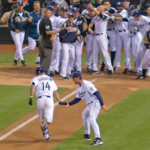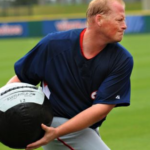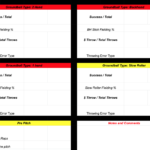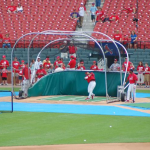Pitching Machines, You Can Have ’em!
As a young coach, I used to lament that our program didn’t have the money to buy pitching machines. I figured someday I would get the program in the a good enough spot financially that I could afford batting machines. Now that my program is on solid enough footing financially to purchase luxuries such like these, I have realized that I don’t want one.
I DO see where a program would use them. If a coach is incapable of throwing batting practice, or has an extra tunnel where they don’t have a live arm to fill, a batting machine could be an acceptable filler to get players some extra swings.
There are two major components of hitting that a pitching machine fails to simulate. There is a popular saying in baseball circles that hitting is timing, and pitching is the disruption of timing. A machine simply does not allow a hitter to work on timing. When to load, when to get the front heel down, and how to pick up the baseball coming out of a live arm are not simulated.
Next time you go to the cages, watch kids as they hit. They will probably either stride way too soon, pause and wait for the ball to shoot out of the machine, or be taken by surprise as the ball shoots out of the machine and not get their front foot down in time. This simply does not simulate what happens in the game.
In addition to not giving realistic timing for hitters, pitching machines also fail to give a hitter cognitive interference. So much of hitting is making a decision on whether to swing or not. A batting machine takes this decision out of the equation. You know the pitch is going to be in a specific area and at a specific velocity.
Not having to make a decision prior to executing a skill (like what would happen in a game) makes it difficult for players to translate skills they are learning into competition. Having a live arm in the cage, even if they are throwing from a shorter distance, requires player to react to the pitch and make a decision prior to swinging. This much more closely simulates what happens in a game.
Additionally, few pitching machines are at the same release point as a pitcher and few create the same angle of the ball as it approaches the plate as a live arm does.
Pitching machines can be used as an effective training tool, but they should not be the primary delivery method for batting practice. If at all possible, players need to hit off live arms to develop timing and learn to make decisions on pitches.
My push for the next few blog posts as I ramp up for the 2016 season will be on how to develop pitch recognition, and how to effectively utilize another tool that coaches rely on heavily, the batting tee.
In the mean time, sign up here to get our UPDATED 5 drills that translate practice to game performance:
Get Our Top 5 Hitting Drills Here
More from my site
 CCA Podcast 037 – 5 ways to score more runs in 2016
CCA Podcast 037 – 5 ways to score more runs in 2016 CCA Podcast 181 – What to do if your hitters are overmatched
CCA Podcast 181 – What to do if your hitters are overmatched Effective Planning of Indoor Baseball Practice
Effective Planning of Indoor Baseball Practice  CCA Podcast 085 – In season strength and conditioning program
CCA Podcast 085 – In season strength and conditioning program CCA Podcast 245 – Running efficient and effective tryouts
CCA Podcast 245 – Running efficient and effective tryouts CCA Podcast 093: Maximizing your batting practice routine
CCA Podcast 093: Maximizing your batting practice routine
 Posted by Kyle Nelson
Posted by Kyle Nelson- Posted in Hitting
 Nov, 17, 2015
Nov, 17, 2015 9 Comments.
9 Comments.
Elite members login here
Check out what’s New/Hot!
Recognizing, Diagnosing, and Fixing Common Hitting Flaws eCourse The 3 metrics we tested on Blast motion sensors this year Sneak Peek Inside an Elite Q and A The batting practice continuum Elite Member’s area table of contents 50+ “Chaos” hitting drills
5 sample Chaos hitting drills FREE
Mental Skills and Culture Building The hitting pyramid Welcome Elite Member, Trey! Ideas for a pitcher first practice 12 week bat speed improvement plan Make plans this offseason to have your team playing their best baseball at the end of the year” Top 5 hitting drills to translate practice skill to game performanceHow we used Blast Motion sensors with a team in 2019
What to do if your hitters are overmatched Welcome Elite Member, Tommy! Setting your baserunners up for success Welcome Elite Member, Mike! A consulting call with Elite Member Matt FREE Web Clinic: Developing Athletic, Consistent, Extraordinary Infielders
 Coach Kyle Nelson
Coach Kyle Nelson
Kyle,
Great observations about pitching machines. Always wanted a live arm throwing when possible. I guess quickness to the ball, ( wait as long as possible with hands back) is something to work on and going to right field might be another drill that could help a hitter.
You are correct in that the ” load ” and timing cannot be worked on at all and I hated that part of hitting on a machine. Concentrating on hips first through the ball might be another area too with a machine.
I’m an old school guy and always tried to take an even, balanced stride to the ball.( Ala Kaline )Picking up that front foot that a lot of players do today, I’m not sure I see the advantage. Great job with your article.
Thanks for your comment and thanks for reading!
I always recall being frustrated by machines as a younger player, but I never really understood why until I studied hitting and the way athletes learn and translate skills from practice to games more in depth. It has become apparent that a lot of the methods I was using made players really good in practice, but not necessarily when it counted.
In regards to the high leg kick, it’s just a timing mechanism. The problem is, when supremely talented MLB players use it, they are getting their front foot down on time. When younger hitters try to emulate it, they do not get their front foot down on time and it over complicates the swing. I believe in allowing for individual “style” in all skills, but when it gets in the way, it has to be changed. Many young hitters cannot handle the leg kick because it complicates an already difficult movement pattern.
Kyle
Excellent article. I agree on the pitching machine. Our youth league switched to Cal Ripken/Babe Ruth 12 yrs ago. With that switch we went from the wheel pitching machines to the spring loaded for our 7/8 age group.
I was always frustrated with the wheel machines because the shot to the same basic spot at the same time. So players didnt learn to adjust to the pitch and only learned to swing to one spot.
The spring maching gets lots of negative comments for being inconsistant but we fount that was its biggest strength. With the ball around the zone the player still had to decide and adjust to the pitch. Also at 1/10th the cost or more they were afordable alternative for that second cage.
I agree with you Live arm is the ONLY good way to get timing and overall hitting down. Good article.
Rob Chalfant
North Arkansas Babe Ruth/Cal Ripken
District 4 and 5 Commissioner
Thanks Rob, glad you enjoyed it. Have a video blog post coming out tomorrow that is of a similar theme.
I’m glad the change was positive for your league. Something that is accurate, but a little inconsistent would be very helpful for young hitters to develop. Will be more difficult now, but will benefit them once that machine turns into a person!
Hope you had a great Thanksgiving!
Yes this is a great article! It also validates what myself and other coaches teach. I see lots of coaches and dads that can’t throw BP to their players or kids. Some have to rely on pitching machines or batting cages(yellow dimple balls).
Throwing Live BP gives a kid a true feel on game situation and arm slot. As a kid gets older, you can work on hitting curveballs,changeups, hitting situations(counts positive and negative counts).
Bunting (sacrifice, quick bunt,slash or(swinging bunt).When you throw BP you can control the situation better. If a kid is struggling with hitting mechanics,you can stop and help the player get back on track.One of the things I hate, is when I see people throwing 15-20 pitches and the kid is using “bad mechanics” because he’s getting tired. The key to throwing BP is quality swings… building correct muscle memory.
Rick-
Your comment brings another question to mind that I have been struggling with… how long are your rounds in the cage? I have gone back and forth between longer rounds (10-12) and shorter rounds (5). Much longer than that and you run into fatigue as you mention. The shorter rounds are good because they simulate game situations better. You never get 10+ consecutive swings in the game.
The problem we ran into was the transition time was killing our productivity in practice. We emphasized quick transitions, but it was still 2 transitions for every one we had before.
I’d be really interested in hearing what others do for the length of round in cage.
Kyle Nelson
Cornerstone Coaching Academy
I’m sure we all remember “batting cage” hitters growing up. The kid who could crush in the cage but couldn’t hit .200 in games. Some of us got cut as those guys made the team.
Jennie Finch used to go around putting on demonstrations of how she could strike out major league hitters. She only threw about 75 tops, but she struck out 23 different players, including Pujols. The reason they couldn’t hit her pitch is because baseball hitters learn from and rely on feedback from experience. They learn to hit with overhand live pitching. Finch’s underhand delivery was new to them, they had no feedback experience with it. Paul Reddick has a video where he discusses this.
So machines to me fail in the ways mentioned above, timing, decision making, and they also fail in providing the hitter useful experience they can draw on later when faced with a real pitcher.
[…] A Baseball Player's Mental Attitude when Filming a Skills Video5 beefy tips for taking your baseball career overseas — Baseball Jobs Overseas Pitching Machines, You Can Have 'em! | Cornerstone Coaching AcademyCornerstone Coaching Ac… […]
[…] A pitching machine for baseball should be used and/or not used in the following situations, as dictated in the […]